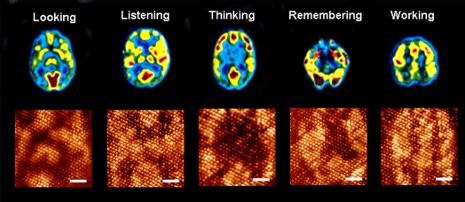Lessons from the Brain: Toward an Intelligent Molecular Computer

A team of researchers from Japan and Michigan Technological University has built a molecular computer using lessons learned from the human brain.
Physicist Ranjit Pati of Michigan Tech provided the theoretical underpinnings for this tiny computer composed not of silicon but of organic molecules on a gold substrate. “This molecular computer is the brainchild of my colleague Anirban Bandyopadhyay from the National Institute for Materials Science,” says Pati. Their work is detailed in “Massively Parallel Computing on an Organic Molecule Layer,” published April 25 online in Nature Physics.
“Modern computers are quite fast, capable of executing trillions of instructions a second, but they can’t match the intelligent performance of our brain,” says Pati. “Our neurons only fire about a thousand times per second. But I can see you, recognize you, talk with you, and hear someone walking by in the hallway almost instantaneously, a Herculean task for even the fastest computer.”
That’s because information processing is done sequentially in digital computers. Once a current path is established along a circuit, it does not change. By contrast, the electrical impulses that travel through our brains follow vast, dynamic, evolving networks of neurons that operate collectively.
The researchers made their different kind of computer with DDQ, a hexagonal molecule made of nitrogen, oxygen, chlorine and carbon that self-assembles in two layers on a gold substrate.
The DDQ molecule can switch among four conducting states—0, 1, 2 and 3—unlike the binary switches—0 and 1—used by digital computers.
“The neat part is, approximately 300 molecules talk with each other at a time during information processing,” Pati says. “We have mimicked how neurons behave in the brain.”
“The evolving neuron-like circuit network allows us to address many problems on the same grid, which gives the device intelligence," Pati says. As a result, their tiny processor can solve problems for which algorithms on computers are unknown, especially interacting many-body problems, such as predictions of natural calamities and outbreaks of disease. To illustrate this feature, they mimicked two natural phenomena in the molecular layer: heat diffusion and the evolution of cancer cells.
In addition, their molecular processor heals itself if there is a defect. This property comes from the self-organizing ability of the molecular monolayer. “No existing man-made computer has this property, but our brain does,” Bandyopadhyay says. “If a neuron dies, another neuron takes over its function.”
“This is very exciting, a conceptual breakthrough,” Pati says. “This could change the way people think about molecular computing.”
Pati’s work at Michigan Tech is supported by the National Science Foundation.
An abstract of “Massively Parallel Computing on an Organic Molecule Layer” is available at Nature Physics. Additional coauthors are Satyajit Sahu and Daisuke Fujita of the National Institute for Materials Science, Japan, and Ferdinand Peper of the National Institute of Information and Communications Technology, Japan.
Michigan Technological University is an R1 public research university founded in 1885 in Houghton, and is home to nearly 7,500 students from more than 60 countries around the world. Consistently ranked among the best universities in the country for return on investment, Michigan's flagship technological university offers more than 185 undergraduate and graduate degree programs in science and technology, engineering, computing, forestry, business, health professions, humanities, mathematics, social sciences, and the arts. The rural campus is situated just miles from Lake Superior in Michigan's Upper Peninsula, offering year-round opportunities for outdoor adventure.
![Tech’s annual Computing [MTU] Showcase comes to campus Oct. 2-4.](http://www.mtu.edu/news/2024/09/images/cyber-security-202110070277-banner450.jpg)



Comments